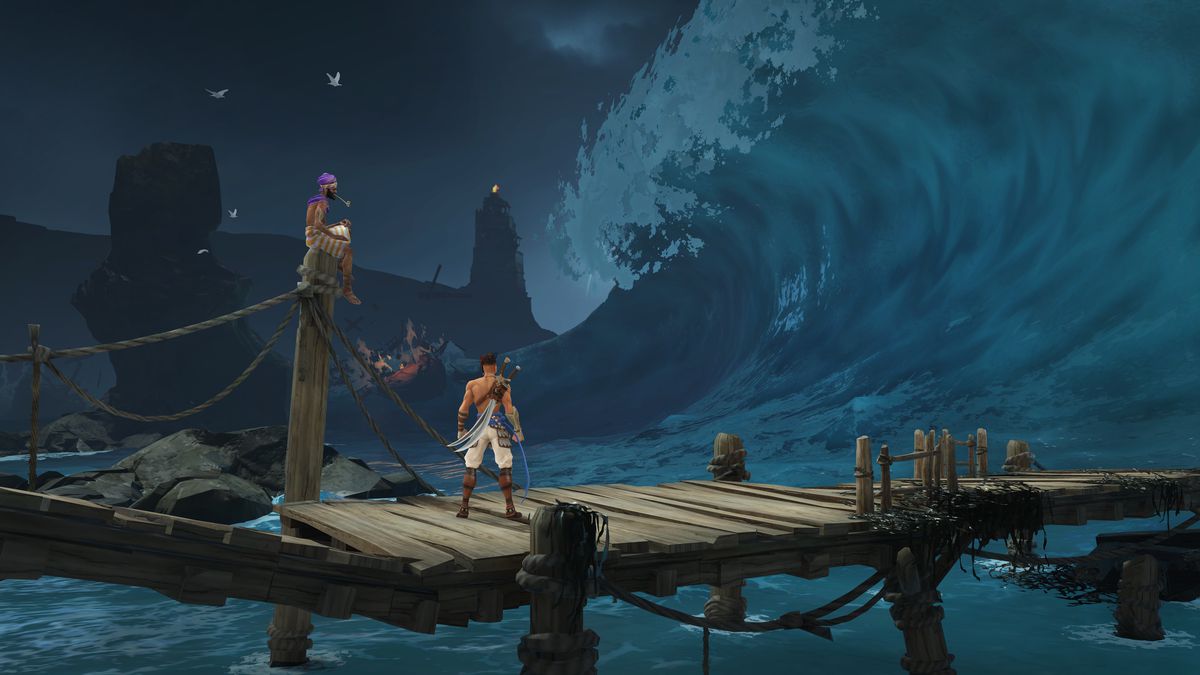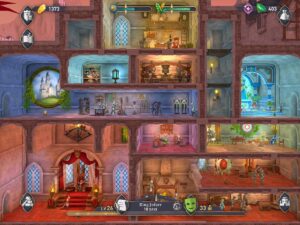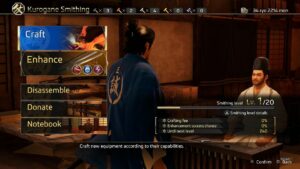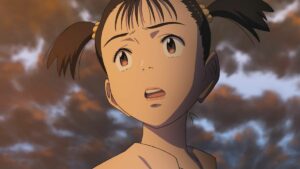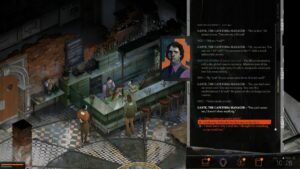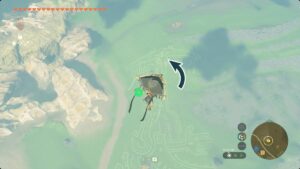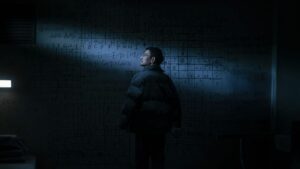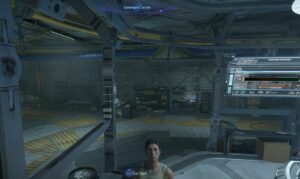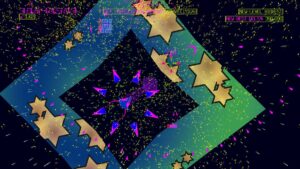Prince of Persia games were once a big enough deal that they made them into a movie, controversially starring Jake Gyllenhaal. In fact, prior to the arrival of Assassin’s Creed in 2007, Prince of Persia was probably Ubisoft’s premier franchise, due in large part to the reputation of 2003 classic The Sands of Time. But the series has fallen on hard times. There hasn’t been a significant Prince of Persia release in the 13 long years since 2010’s The Forgotten Sands, while a planned remake of The Sands of Time has gone back to the drawing board.
In this context comes Prince of Persia: The Lost Crown, a low-budget, low-stakes, sort of soft reboot for the franchise. It’s a tribute to the series’ side-scrolling roots in Jordan Mechner’s 1989 original, and can be read as a gentle reminder to the world at large that these games exist. Perhaps it’s also a toe in the water from Ubisoft to gauge the real-world popularity of a series it has been struggling to keep relevant, as well as a relatively safe space in which to figure out how a series rooted in both traditional Middle Eastern folklore and a certain strain of colonialist adventure fiction can work in the 2020s, representationally speaking.
The Lost Crown, developed by Ubisoft’s Montpellier studio in the south of France — the home of Rayman — is due out on Jan. 18, 2024, for Nintendo Switch, PlayStation 4, PlayStation 5, Windows PC, Xbox One, and Xbox Series X. I had a chance to play it for a few hours via a remote preview event, and found it to be a brisk, entertaining Metroidvania-style game with crisp combat and engrossing level design… and it’s a game that doesn’t star the Prince of Persia at all.
:no_upscale()/cdn.vox-cdn.com/uploads/chorus_asset/file/25157361/PoPTLC_Screenshot_Raging_Sea_13122023_6PM_CET.jpg)
This might be the most puzzling choice Ubisoft Montpellier has made. The character of the swashbuckling Prince has been at the heart of the series since day one; it was his acrobatic move set, as captured in Mechner’s amazingly lifelike rotoscoped animation, that won the first game its acclaim. But while the character you play in The Lost Crown bears a strong resemblance to many previous incarnations of the Prince — swapping those 2003 curtains for a more aggressive mohawk, but keeping the trademark white pantaloons and bare chest — the Prince he is not. He is Sargon, one of seven legendary Persian warriors called the Immortals, and it’s the titular Prince, Ghassan, whom he’s out to save.
Sargon’s overconfident young buck persona is a bit of a video game cliche, and personally I found it a downgrade from the more classical romantic heroism of earlier versions of the Prince. I also didn’t find myself much engaged by The Lost Crown’s story, which involves the Immortals setting off in search of Ghassan after his treacherous abduction in the midst of a war — although I appreciate that Ubisoft Montpellier is attempting to flesh out the rather basic, and at times Orientalist, archetypes of the earlier games with a more richly imagined world of myths, monsters, and warring factions drawn directly from Persian mythology. (There’s even a Farsi language option for spoken dialogue.)
One of the more successful narrative gambits goes back to the same well as The Sands of Time and brings time itself into play. There’s no suggestion (yet, anyway) that Sargon will get the power to manipulate time itself, but his adventure takes him into areas where time is in flux: ruins float precariously in midair, caught in the act of collapse, while characters appear to stray into the narrative from both past and future, some appearing to have lived decades within hours. There are some intriguing setups here, and it will be interesting to see how they pay off in the full game.
Mechanically, The Lost Crown is on much firmer ground. At Ubisoft Montpellier, game director Mounir Radi can draw on the institutional knowledge that informed Rayman Origins and Legends; these people know how to make sharp, inventive 2D platform games. The Lost Crown foregrounds combat first, concentrating on teaching you to combine Sargon’s hard-pressing attacks with parries and swift dodges. (There are launches, juggles, air attacks, and more to learn in combat training, plus powerful moves that can be charged up by dealing damage without taking it.) Enemies hit hard, but damage sponges are rare; fighting in The Lost Crown is more about managing the space around you and the attack patterns of various different enemy types.
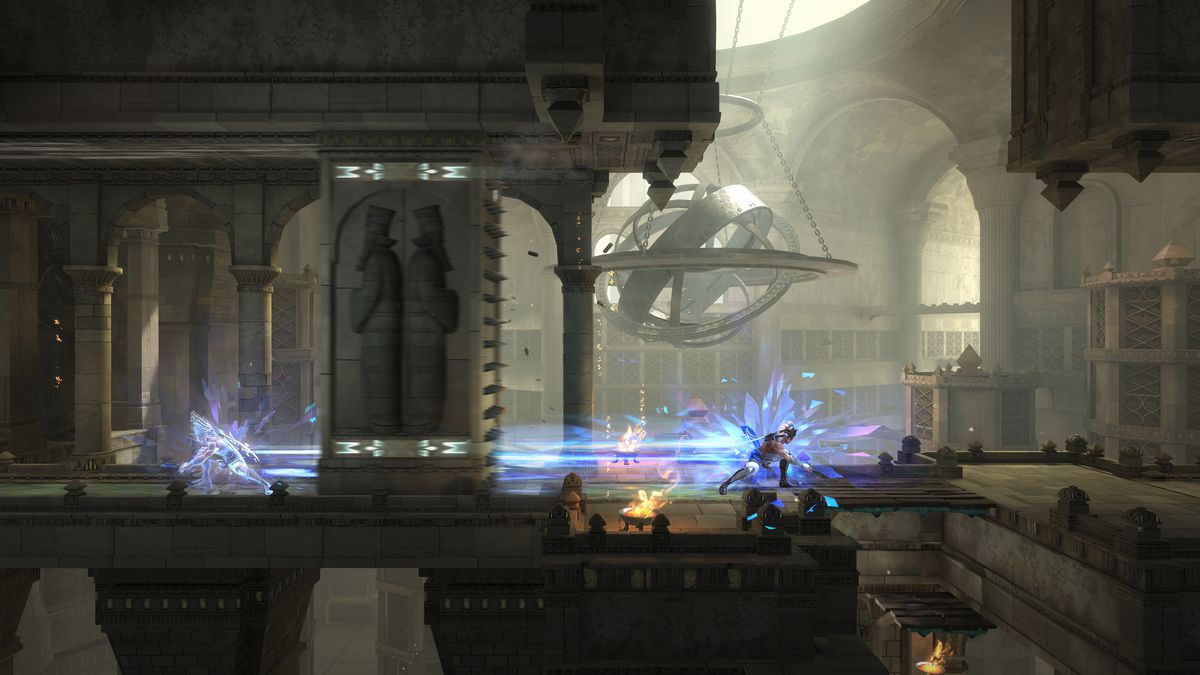
It’s a while before The Lost Crown bares its teeth as a pure platformer, which may be surprising to those who remember the trap gauntlets of The Sands of Time, never mind the pixel-perfect assault courses of the 1989 game. But rest assured that those challenges do eventually arrive, mostly after Sargon acquires a bow; you’ll need nimble fingers to aim and loose arrows mid-jump to trigger the next platform, as the game often demands. (There’s an automatic platforming assist mode available in the accessibility settings.) This is a kind of platforming very specific to Prince of Persia, requiring short chains of involved, precise acrobatic moves that are satisfying to pull off.
But more than a pure combat or platforming game, The Lost Crown is a Metroidvania. It has a labyrinthine map that opens up in an organic, nonlinear fashion. There’s plenty of backtracking and gear-gating involved in its level design, but it’s also possible to discover and explore new areas before the story takes you there. A smattering of side quests encourages careful exploration, too. While I may not have felt all that involved in the story’s opening hours, I did start to develop a strong sense of place in The Lost Crown: It offers a contiguous patchwork of distinct locations (dank cellars, humid forests, golden palaces), each with its own atmosphere and menagerie, each linked in circuitous and unexpected ways.
That’s all you can ask of a Metroidvania, and it turns out to be a great place for Prince of Persia to find its feet again after a decade on the benches. The actual Prince may be in another castle, but so far his game series feels right at home.
- SEO Powered Content & PR Distribution. Get Amplified Today.
- PlatoData.Network Vertical Generative Ai. Empower Yourself. Access Here.
- PlatoAiStream. Web3 Intelligence. Knowledge Amplified. Access Here.
- PlatoESG. Carbon, CleanTech, Energy, Environment, Solar, Waste Management. Access Here.
- PlatoHealth. Biotech and Clinical Trials Intelligence. Access Here.
- Source: https://www.polygon.com/23998446/prince-of-persia-the-lost-crown-hands-on
- :has
- :is
- :not
- :where
- $UP
- 13
- 2024
- 2D
- a
- About
- accessibility
- Acquires
- Act
- actual
- Adventure
- After
- again
- aggressive
- aim
- AIR
- All
- also
- Although
- an
- and
- animation
- Another
- appear
- appears
- appreciate
- ARE
- areas
- around
- arrival
- AS
- ask
- assault
- assist
- assured
- At
- Atmosphere
- attack
- Attacks
- attempting
- Automatic
- available
- back
- basic
- BE
- Bears
- been
- before
- Big
- Bit
- Blue
- both
- Bright
- Brings
- but
- by
- called
- CAN
- captured
- careful
- caught
- certain
- chains
- challenges
- Chance
- character
- characters
- charged
- choice
- classic
- Collapse
- combat
- combine
- comes
- context
- courses
- CRISP
- Crown
- damage
- Dash
- day
- deal
- dealing
- decade
- decades
- demands
- Design
- develop
- developed
- dialogue
- DID
- different
- directly
- Director
- discover
- distinct
- do
- Doesn’t
- Downgrade
- draw
- drawing
- drawn
- due
- each
- Earlier
- eastern
- encourages
- enemies
- engaged
- enough
- entertaining
- Ether (ETH)
- Even
- Event
- eventually
- exist
- exploration
- explore
- fact
- factions
- Fallen
- far
- Fashion
- feels
- Feet
- felt
- few
- Fiction
- fighting
- Figure
- Find
- First
- Float
- FLUX
- For
- forgotten
- found
- France
- Franchise
- from
- full
- future
- game
- game series
- Games
- gauge
- gentle
- get
- Goes
- Golden
- great
- Ground
- had
- Hard
- Have
- he
- Heart
- here
- him
- his
- Hit
- Home
- HOURS
- How
- How To
- HTTPS
- huge
- humid
- i
- imagined
- Immortals
- in
- informed
- Institutional
- interesting
- into
- intriguing
- involved
- involves
- IT
- ITS
- itself
- Jan
- Jordan
- jpg
- Keep
- keeping
- Kind
- Know
- knowledge
- language
- large
- launches
- LEARN
- leaving
- legendary
- Level
- linked
- locations
- Long
- lost
- made
- make
- managing
- many
- map
- May..
- metroidvania
- Middle
- might
- mind
- Mode
- Mohawk
- more
- most
- mostly
- move
- moves
- movie
- much
- myself
- NARRATIVE
- Need
- never
- New
- next
- nimble
- Nintendo
- Nintendo Switch
- no
- obstacle
- of
- off
- Offers
- often
- on
- once
- ONE
- opening
- opens
- Option
- or
- organic
- original
- out
- own
- part
- past
- patterns
- Pay
- PC
- People
- perhaps
- Personally
- Place
- planned
- platform
- plato
- Plato Data Intelligence
- PlatoData
- Play
- playstation
- Playstation 4
- PlayStation 5
- Plenty
- plus
- Polygon
- popularity
- possible
- power
- powerful
- precise
- premier
- Preview
- previous
- Prince
- Prior
- probably
- quests
- Race
- RARE
- rather
- Read
- real world
- relatively
- release
- relevant
- remember
- reminder
- remote
- reputation
- REST
- returns
- right
- rooted
- roots
- RUINS
- safe
- same
- Save
- Search
- see
- sense
- Series
- SERIES X
- set
- setting
- settings
- seven
- sharp
- Short
- side
- significant
- since
- So
- so Far
- Soft
- some
- South
- Space
- speaking
- specific
- spoken
- stands
- Star
- start
- Story
- Stray
- strong
- Struggling
- studio
- successful
- surprising
- swapping
- SWIFT
- Switch
- takes
- taking
- Teaching
- than
- that
- The
- the world
- Them
- There.
- These
- they
- this
- those
- Through
- time
- times
- to
- too
- toward
- trademark
- traditional
- trail
- Training
- tribute
- trigger
- Tsunami
- turns
- types
- Ubisoft
- Unexpected
- various
- very
- via
- Video
- video game
- war
- Warriors
- was
- watches
- Water
- ways
- webp
- WELL
- were
- which
- while
- white
- WHO
- whom
- will
- windows
- with
- within
- without
- Won
- Work
- world
- X
- xbox
- Xbox One
- xbox series
- Xbox Series X
- years
- yet
- you
- young
- zephyrnet

